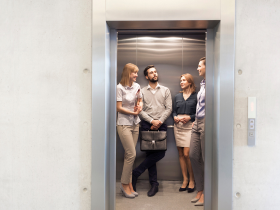The landscape of vertical transportation is undergoing a revolutionary transformation with the advent of smart elevator technology. In this blog, we explore the exciting realm of smart elevators and the futuristic possibilities they bring to urban mobility.
Smart elevators are at the forefront of the digital revolution, redefining the way we move vertically in buildings. This blog delves into the features and potential of smart elevators, offering a glimpse into the future of urban mobility.
Connected Systems and IoT Integration:
Smart elevators are characterized by their connectivity. Internet of Things (IoT) integration allows elevators to communicate in real-time, offering predictive maintenance insights, analyzing usage patterns and optimizing travel routes for efficiency.
Destination Control Systems:
One of the key features of smart elevators is destination control systems. Unlike traditional systems, these smart controls allow passengers to input their desired floor before entering the elevator, optimizing travel patterns and reducing wait times.
Biometric Security and Access Control:
Security is a top priority in smart elevators. Biometric authentication, such as fingerprint or facial recognition, ensures secure access to designated floors, adding an extra layer of safety to vertical transportation.
Energy Efficiency Through Machine Learning:
Smart elevators leverage machine learning algorithms to analyze usage patterns and adjust energy consumption accordingly. By learning from data, these elevators optimize their operation, reducing energy waste and contributing to overall sustainability.
Augmented Reality in Maintenance:
The future of elevator maintenance lies in augmented reality. Technicians equipped with AR devices can access real-time information about the elevator's status, receive step-by-step repair instructions and streamline the maintenance process for enhanced efficiency.
Autonomous and Self-Learning Elevators:
As technology advances, the concept of autonomous elevators comes into play. Self-learning elevators can adapt to changing usage patterns, anticipate maintenance needs and operate with minimal human intervention, revolutionizing the efficiency of vertical transportation.
Conclusion:
The era of smart elevators is here, offering a glimpse into a future where vertical transportation is not only efficient but also seamlessly integrated into the fabric of smart buildings. As we embrace this technological evolution, the sky is no longer the limit for urban mobility.

